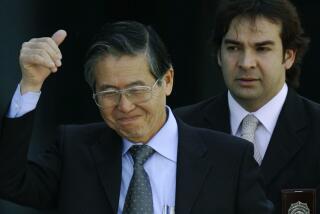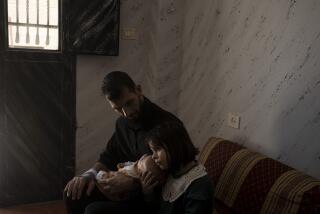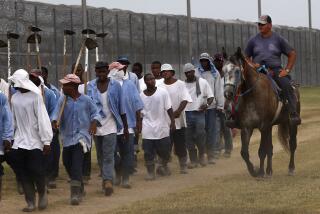Peruvian Prison Life Is Backdrop to Hostage Crisis
LIMA, Peru — Otilia Polay will never forget her shock at seeing her son Victor after his 14 months of solitary confinement. The once-robust middle-aged man had lost 60 pounds, she said. He could barely see after having been imprisoned in the dark for so long. And he complained that security forces had beaten him so badly they had broken his collarbone.
Even today, a year later, the convicted Tupac Amaru terrorist is restricted to a 6-by-6-foot space.
“They’re not cells, they’re tombs,” declared his mother, who is permitted to visit him for half an hour a month.
The seizure by leftist guerrillas of the Japanese ambassador’s residence here has focused new attention on the small Tupac Amaru Revolutionary Movement group and the draconian conditions in which its members are held. The rebels--who released the Guatemalan ambassador Thursday but who are still holding more than 100 VIP hostages in an anxious standoff--have assailed prison conditions and insisted that hundreds of their guerrilla comrades be freed.
Most analysts consider it unlikely that President Alberto Fujimori, who has fiercely fought terrorism, will release rebel leaders from jail. But some say improving prison conditions could be part of a solution to the crisis.
“This is an elemental condition” for the rebels, said Jaime Antesana, an expert on guerrillas.
While condemning the hostage-taking, Peru’s Roman Catholic Church has declared that the rebels’ insistence on improved prison conditions is “reasonable” and should be considered.
International Red Cross officials also complained Thursday that, since the crisis began, the Peruvian government had banned their usual visits to jails to check on convicted terrorists. Steven Anderson, a spokesman, said the humanitarian group was “making representations at the highest levels” about the matter.
On Thursday, the ninth day of the crisis, the guerrillas freed Guatemalan Ambassador Jose Maria Argueta. He said the rebels’ gesture was to mark the signing of peace accords by Guatemala’s government and left-wing rebels this weekend.
*
But the fate of the remaining 103 hostages remained uncertain. In a vivid reminder of their precarious situation, an explosion shook the Japanese ambassador’s residence early Thursday.
A Red Cross spokesman, Roland Bigler, said later that the blast had caused no injuries and was “provoked by an animal.” While he did not elaborate, some of the 400 or so hostages freed so far have reported that the diplomatic compound is mined.
Experts say the left-wing Tupac Amaru has fewer than 100 fighters. About 400 others are behind bars, including much of the group’s leadership.
Among the guerrillas that the group is hoping to free are Polay, its former leader; Miguel Rincon, who allegedly planned an assault on Congress last year; and Maria Lucero Cumpa, a senior rebel.
In communiques sent to the media--some by e-mail--the terrorist group has continuously condemned the treatment the imprisoned guerrillas have received and asked for telephone contact with them. That has not been granted.
Polay’s mother, who runs a hardware store in the Lima suburb of Callao, said that even her once-a-month visits to her son have been cut off since the hostage crisis began Dec. 17.
Since his imprisonment, her 44-year-old son has been denied telephone contact with his family and is permitted only half an hour a day to exercise on a patio, she said. The rest of the time he is locked in his tiny cell, receiving meals through a small trapdoor and using a hole in the floor for a toilet, she said.
“For 23 1/2 hours a day, he’s in a tomb,” she said.
Fujimori established the tough prison regimen for the guerrillas as part of a broad crackdown begun in 1992.
The system allows rebels to be denied any family contact for a year. Even after that, few visits are permitted, and prisoners are allotted 60 cents a day of food, said Susana Silva of the government’s new human rights office.
“We have various cases of people going crazy,” she said in a telephone interview. “You can imagine 23 1/2 hours in a place that’s completely closed, having nowhere to walk, no chance to talk.”
Still, few Peruvians protest the prisoners’ conditions. Many credit Fujimori’s tough approach for crippling the Sendero Luminoso, or Shining Path, rebels, whose war against the state claimed nearly 30,000 lives through the early 1990s.
The Tupac rebels are not considered as fanatical as Sendero Luminoso. But they receive little public sympathy.
For example, Caretas, a weekly Peruvian newsmagazine, published photos Thursday of an underground brick cell where it said the Tupac guerrillas had held kidnap victims.
“Now the [rebels] complain about the harsh conditions that their leaders suffer--the same ones who ordered and carried out these kidnappings,” the magazine said.
Even human rights activists say that Fujimori had no choice but to impose some discipline on the prisons.
Previously, jailed rebels often remained active in their groups, using visitors as messengers. Jail breaks also were frequent. In one spectacular operation in 1990, Tupac freed 47 members by digging a tunnel into the prison.
Other prisoners virtually ran many jails.
But, said Francisco Soberon, director of the human rights organization Aprode: “From one extreme, we passed to the other.”
Recently, the Fujimori government has rebuilt many jails to provide more space and better eating facilities, officials say.
But that has meant little to convicted terrorists. That was clear to Mark and Rhoda Berenson of New York City, who were allowed to visit their daughter Lori, 27, this month for the first time since she was convicted last year of aiding the Tupac guerrillas.
Lori Berenson is serving a life sentence at the notorious Yanamayo prison, an unheated building about 12,000 feet above sea level in the Andean mountains. The cold is so severe that their daughter bundles up in sweaters and suffers swollen and bruised hands, the Berensons said.
“Her fingers were sort of grotesque . . . sort of deformed,” her father told Associated Press.
Lori hasn’t been physically abused. But she was permitted only small amounts of icy water and unheated food, according to her father. She has a permanent cold and shares a tiny cell.
More to Read
Sign up for Essential California
The most important California stories and recommendations in your inbox every morning.
You may occasionally receive promotional content from the Los Angeles Times.










